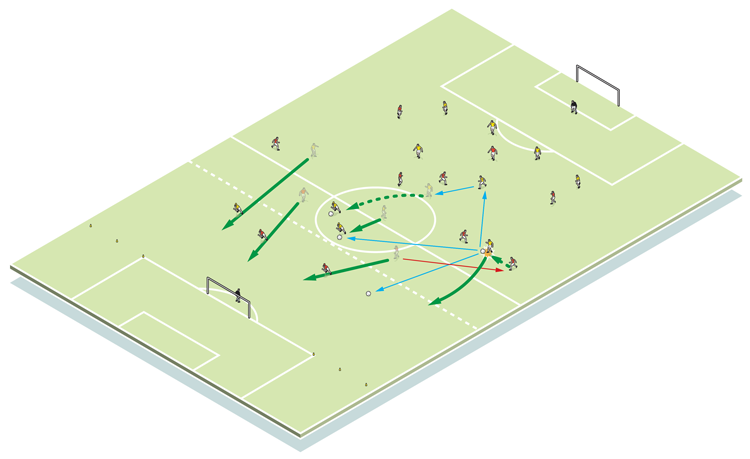




OUR BEST EVER OFFER - SAVE £100/$100
JOIN THE WORLD'S LEADING PROFESSIONAL DEVELOPMENT PROGRAMME
- 12 months membership of Elite Soccer
- Print copy of Elite Player & Coach Development
- Print copy of The Training Ground
Transition to attack
Use this session to examine your players’ ability to attack quickly and create overloads from an organised team shape.
| Area | Up to a full pitch |
| Equipment | Balls, cones, goals |
| No. of Players | Up to 9v9 |
| Session Time | Overload exercise 10mins, Game 1 20mins, Game 2 20mins |
This session examines players’ ability to attack quickly and create overloads from an organised team shape.
It’s a modern trend within the game and offers our team a clear route to goal, with players taking on and mastering defined roles as part of a tight and efficient unit.
What do I get the players to do?
Overload exercise
We begin with a 4v2 overload warm-up in a narrowed penalty box extended down the pitch. Two red defenders must organise to repel the threat of the four yellow attackers. If they win the ball back the practice restarts. We progress this by telling the deep midfielder to recover after the first pass, with the main attack being a 3v2 (1).
1

Attacking game 1
We set up with a goal on the 18-yard line, with the pitch coned across 10 yards into the bottom half. This small area represents a ‘safe zone’, where two unopposed defenders sit. They pass the ball out to begin the attacking move.
Should yellows turn over possession they cannot immediately counter-attack - we want them to think about switching, making a square pass or even playing the ball backwards, before then going forward, in order to keep opponents from immediately pressing the ball (2a).
2a

When a pass breaks the coned line, both defenders can move back to defend, though four attackers can move into the space.
To progress, yellows can now make any pass, including a quick ball forward (2b). And in the final progression, only one red can defend behind the coned line, against as many as five attackers.
2b

Attacking game 2
Next we play 9v9, full pitch, with zones at both ends, which act as offside lines. Attackers can have two players running beyond this line who will be unopposed if a pass can be played through. Defending players cannot drop deeper than this line, allowing space into which we can play through-balls and create 1v1 situations against the keeper (3a).
3a

To progress, we can allow more attackers and defenders beyond that line, such as 4v2s or 4v3s (3b).
3b

What are the key things to look out for?
Technically, we want to see players running with the ball, playing with their heads up, a good quality of pass and movement and accomplished decision making.
Tactically, the session relies on good organisation, players being able to break the lines when regaining, and movement in the sense of how, when and where we can get to where we need to be on the pitch.
Related Files
Editor's Picks
Attacking transitions
Deep runs in the final third
Using the goalkeeper in build-up play
Intensive boxes drill with goals
Penetrating the final third
Creating and finishing
My philosophy
Pressing initiation
Compact team movement
Coaches' Testimonials

Alan Pardew

Arsène Wenger

Brendan Rodgers

Carlos Carvalhal

José Mourinho

Jürgen Klopp

Pep Guardiola

Roy Hodgson

Sir Alex Ferguson

Steven Gerrard
Coaches' Testimonials

Gerald Kearney, Downtown Las Vegas Soccer Club

Paul Butler, Florida, USA

Rick Shields, Springboro, USA

Tony Green, Pierrefonds Titans, Quebec, Canada
Join the world's leading coaches and managers and discover for yourself one of the best kept secrets in coaching. No other training tool on the planet is written or read by the calibre of names you’ll find in Elite Soccer.
In a recent survey 92% of subscribers said Elite Soccer makes them more confident, 89% said it makes them a more effective coach and 91% said it makes them more inspired.
Get Monthly Inspiration
All the latest techniques and approaches
Since 2010 Elite Soccer has given subscribers exclusive insight into the training ground practices of the world’s best coaches. Published in partnership with the League Managers Association we have unparalleled access to the leading lights in the English leagues, as well as a host of international managers.
Elite Soccer exclusively features sessions written by the coaches themselves. There are no observed sessions and no sessions “in the style of”, just first-hand advice delivered direct to you from the coach.







